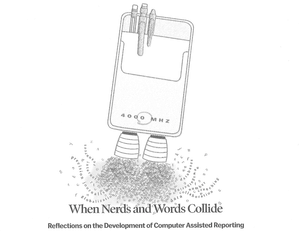Posts by hdcoadmin
When nerds and words collide
In 1999, Nora Paul organized a gathering at The Poynter Institute of a group of journalists who were on the cutting edge of computer-assisted reporting at the time. The result was a short book titled “When Nerds and Words Collide,” featuring chapters from many leaders in data-driven journalism. It also details the beginning of what…
Read MoreNew webinar: Spycraft for journalists
Watch now: Spycraft for Journalists Keep your sources and your secrets safe from prying eyes. In IRE’s latest webinar, Steve Doig, Knight Chair in Journalism at Arizona State University, explains spycraft for journalists. This webinar covers the use of cryptography, spoofing caller ID, anonymous email, throwaway phones, steganography and other covert techniques for communicating with…
Read MoreHow journalists can learn safer communication and improve online security
The New York Times Magazine this week profiles documentary filmmaker Laura Poitras and her role in helping National Security Agency contractor Edward Snowden leak thousands of classified documents regarding government surveillance programs. From the magazine: Poitras possesses a new skill set that is particularly vital — and far from the journalistic norm — in an…
Read MoreMuckRock analysis finds 27 percent of FOIA requests still unfulfilled after three months
MuckRock, a public records service that files and tracks requests on behalf of journalists, researchers, activists and historians, recently analyzed 907 requests completed by its users. The analysis found about 42 percent of federal Freedom of Information Act requests were completed on time, and 27 percent of those 907 requests are still without a response after…
Read MoreDecades-old rape kits finally being tested
After finding out that the Cleveland Police Department had no idea how many rape kits were in their evidence room, Plain Dealer reporters Rachel Dissell and Leila Atassi started digging into how sexual assault cases were handled in their city. Finally, “unsolved crimes by the dozens are returning to Cleveland with DNA matches and the…
Read MoreSan Diego law enforcement relied on troubled nonprofit to teach corrective behavior
For community service and corrective classes, San Diego law enforcement has sent defendants to organizations like the Corrective Behavior Institute for community service. In doing so, it has “sent people who haven’t followed the rules to a nonprofit that hasn’t followed them either,” according to an investigation by the Voice of San Diego, which found shoddy…
Read MoreSponges, tools and more left inside Washington hospital patients
KUOW in Seattle reports that about 30 times per year, a sponge or surgical instrument is left inside a patient at a hospital in Washington state. Foreign ojects left behind are among the state’s most common medical mistakes. Medical experts told KUOW such an event should never happen, at that the system in place to…
Read MoreHow reporter Steven Hsieh stumbled across his first investigation
Reporter Steven Hsieh was never informed about a dangerous landfill in his hometown of West County in St. Louis until one day while watching cable news. Hsieh, one-year out of school at the Missouri School of Journalism, stumbled upon a broadcast of a roundtable discussion in which Diane Schanzenbach, associate professor in the School of…
Read MoreTableau Public expands to 1 million rows
Tableau Software is announcing that Tableau Public now has expanded capabilities, including handling spreadsheets that that contain up to 1million rows of data. Tableau Public’s storage space has also increased from 50 megabytes to 1 gigabyte. Tableau stated the changes were made after noticing many public datasets number more than the previous limit of 100,00…
Read MoreDespite publicity for transparency, fear and self-censorship in Tanzania
Anti-press attacks are generating fear and self-censorship among journalists in Tanzania, according to a report published Wednesday by The Committee to Protect Journalists. Despite good international publicity for moving toward an open government, public discontent remains largely unseen and unheard. CPJ’s findings include 10 serious anti-press attacks since September, which is “a notable jump over historical trends…
Read More The IRE office will be closed from December 25th to January 5th.
The IRE office will be closed from December 25th to January 5th.

